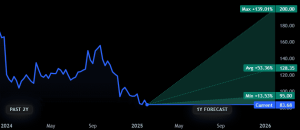Gold futures on Wednesday traded solidly lower, losing all of its gains and then some from the previous session, as investors assessed the latest development in Eastern Europe between Russia and Ukraine.
A updraft in global stocks and a modest rise in yields also appeared to be creating some headwinds for bullion, which had been enjoying an upswing amid intensifying tensions between Moscow and the West over troop deployments into Donbas regions of Ukraine and growing fears of a full-scale invasion of Kyiv.
Some strategists are making the case that the conflict brewing in Ukraine may do less harm to the rest of the world’s economy.
“The notion that even if a war in Ukraine is inevitable the broader economic fallout might not be so devastating after all might slowly be creeping into the markets, thus lifting sentiment slightly today,” wrote Raffi Boyadjian, lead investment analyst at XM.com, in a daily note.
Against that backdrop, April gold
GCJ22,
GC00,
was trading $10.20, or 0.5%, to reach $1,897.10 an ounce, following a 0.4% gain on Tuesday.
“The somewhat more positive tone weighed on safe havens such as gold, the Japanese yen and Swiss franc, Boyadjian said, referring to assets perceived as havens during times of uncertainty.
Meanwhile, the dollar held slightly lower, down 0.1%, as gauged by the ICE U.S. Dollar Index
DXY,
and yields for benchmark government debt were headed up, notably the 10-year Treasury note rate
TMUBMUSD10Y,
which climbed by about 2 basis points.
A weaker dollar should lift appetite for dollar-pegged assets such as gold among overseas buyers but the rise of Treasury yields also can undercut appetite for bullion compared against nonyielding gold and silver.
Investors have been closely watching developments in Eastern Europe, with the threat of war adding to investor unease.
On top of that, the Federal Reserve seems determined to lift interest rates aggressively, as early as next month, to combat a surge in inflation, with such monetary policy moves usually serving as a bearish factor for precious metals.
This post was originally published on Market Watch






